what-when-how
In Depth Tutorials and Information
(A)
L1L4
Hip
.1
.05
0
-.05
1
2
3
4
5
Femoral neck
.1
.05
Treatment group
No treatment
Pamidronate
Alendronate/residronate
0
-.05
1
2
3
4
5
Years from baseline BMD
(B)
L1L4
Hip
.1
.05
0
-.05
1
2
3
4
5
Femoral neck
.1
Treatment group
.05
No treatment
Pamidronate
Alendronate/residronate
0
-.05
1
2
3
4
5
Years from baseline BMD
FIGURE 55.2
(A) Projected levels of BMD change for type I OI patients by treatment group and site starting at a baseline measurement
across a span of 5 years. The projected BMD changes are based on annualized linear rates of change (95% CI) adjusted for age at baseline DXA
scan and gender. (B) Projected levels of BMD change for type III/IV OI patients by treatment group and site starting at a baseline measurement
across a span of 5 years. The projected BMD changes are based on annualized linear rates of change (95% CI) adjusted for age at baseline DXA
scan and gender.
BMD at the hip in the type III/IV patients. Analysis
of the site-specific effects of bisphosphonates on BMD
indicated that the femur neck was unresponsive to
bisphosphonate treatment. While the reason for this
disparity was not apparent, experience in patients
with age-related osteoporosis indicates that the BMD
response to bisphosphonates at the femur neck is fre-
quently less than that observed at the lumbar spine.
42
Pamidronate led to a significant decrease in fracture
rate only in the type III/IV patients during the 5-year
period of observation (
p
= 0.05): fracture incidence
did not decrease in the type I patients. First, the post-
to pre-treatment fracture ratio decreased, but not to
a significant extent in all groups including the non-
treatment group, except for type I patients with pami-
dronate or oral bisphosphonate treatment where the
ratio increased to a marginal extent. We suggest that
this improvement in the non-treatment group illustrates














































